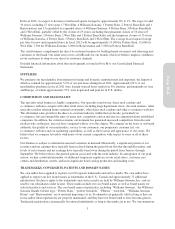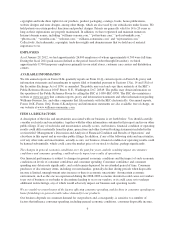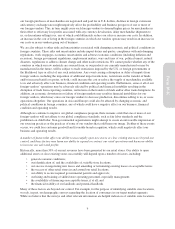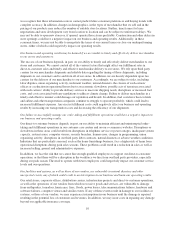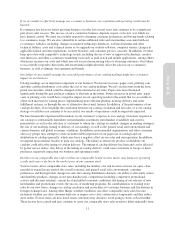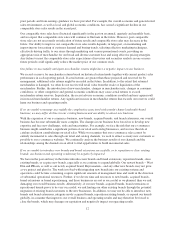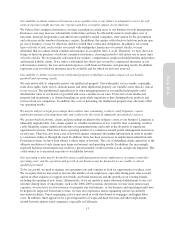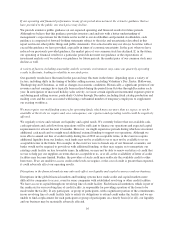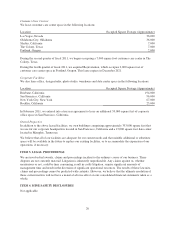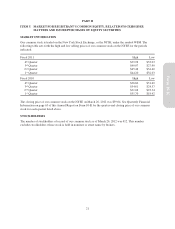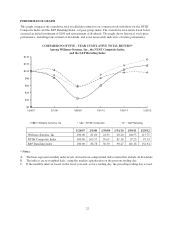Pottery Barn 2011 Annual Report Download - page 26
Download and view the complete annual report
Please find page 26 of the 2011 Pottery Barn annual report below. You can navigate through the pages in the report by either clicking on the pages listed below, or by using the keyword search tool below to find specific information within the annual report.prior periods and from earnings guidance we have provided. For example, the overall economic and general retail
sales environment, as well as local and global economic conditions, has caused a significant decline in our
comparable store sales results in the recent past.
Our comparable store sales have fluctuated significantly in the past on an annual, quarterly and monthly basis,
and we expect that comparable store sales will continue to fluctuate in the future. However, past comparable
store sales are not necessarily an indication of future results and comparable store sales may decrease in the
future. Our ability to improve our comparable store sales results depends, in large part, on maintaining and
improving our forecasting of customer demand and buying trends, selecting effective marketing techniques,
effectively driving traffic to our stores through marketing and various promotional events, providing an
appropriate mix of merchandise for our broad and diverse customer base and using effective pricing strategies.
Any failure to meet the comparable store sales expectations of investors and securities analysts in one or more
future periods could significantly reduce the market price of our common stock.
Our failure to successfully anticipate merchandise returns might have a negative impact on our business.
We record a reserve for merchandise returns based on historical return trends together with current product sales
performance in each reporting period. If actual returns are greater than those projected and reserved for by
management, additional sales returns might be recorded in the future. In addition, to the extent that returned
merchandise is damaged, we often do not receive full retail value from the resale or liquidation of the
merchandise. Further, the introduction of new merchandise, changes in merchandise mix, changes in consumer
confidence, or other competitive and general economic conditions may cause actual returns to exceed
merchandise return reserves. In particular, the recent adverse economic conditions resulted and may again result
in increased merchandise returns. Any significant increase in merchandise returns that exceeds our reserves could
harm our business and operating results.
If we are unable to manage successfully the complexities associated with a multi-channel and multi-brand
business, we may suffer declines in our existing business and our ability to attract new business.
With the expansion of our e-commerce business, new brands, acquired brands, and brand extensions, our overall
business has become substantially more complex. The changes in our business have forced us to develop new
expertise and face new challenges, risks and uncertainties. For example, we face the risk that our e-commerce
business might cannibalize a significant portion of our retail and catalog businesses, and we face the risk of
catalog circulation cannibalizing our retail sales. While we recognize that our e-commerce sales cannot be
entirely incremental to sales through our retail and catalog channels, we seek to attract as many new customers as
possible to our e-commerce websites. We continually analyze the business results of our channels and the
relationships among the channels in an effort to find opportunities to build incremental sales.
If we are unable to introduce new brands and brand extensions successfully, or to reposition or close existing
brands, our business and operating results may be negatively impacted.
We have in the past and may in the future introduce new brands and brand extensions, reposition brands, close
existing brands, or acquire new brands, especially as we continue to expand globally. Our newest brands – West
Elm and PBteen, as well as our newly acquired brand, Rejuvenation – and any other new brands, may not grow
as we project and plan for. The work involved with integrating new brands into our existing systems and
operations could be time consuming, require significant amounts of management time and result in the diversion
of substantial operational resources. Further, if we devote time and resources to new brands, acquired brands,
brand extensions or brand repositioning, and those businesses are not as successful as we planned, then we risk
damaging our overall business results. Alternatively, if our new brands, acquired brands, brand extensions or
repositioned brands prove to be very successful, we risk hurting our other existing brands through the potential
migration of existing brand customers to the new businesses. In addition, we may not be able to introduce new
brands and brand extensions, integrate newly acquired brands, reposition existing brands, or expand our brands
globally, in a manner that improves our overall business and operating results and may therefore be forced to
close the brands, which may damage our reputation and negatively impact our operating results.
12





